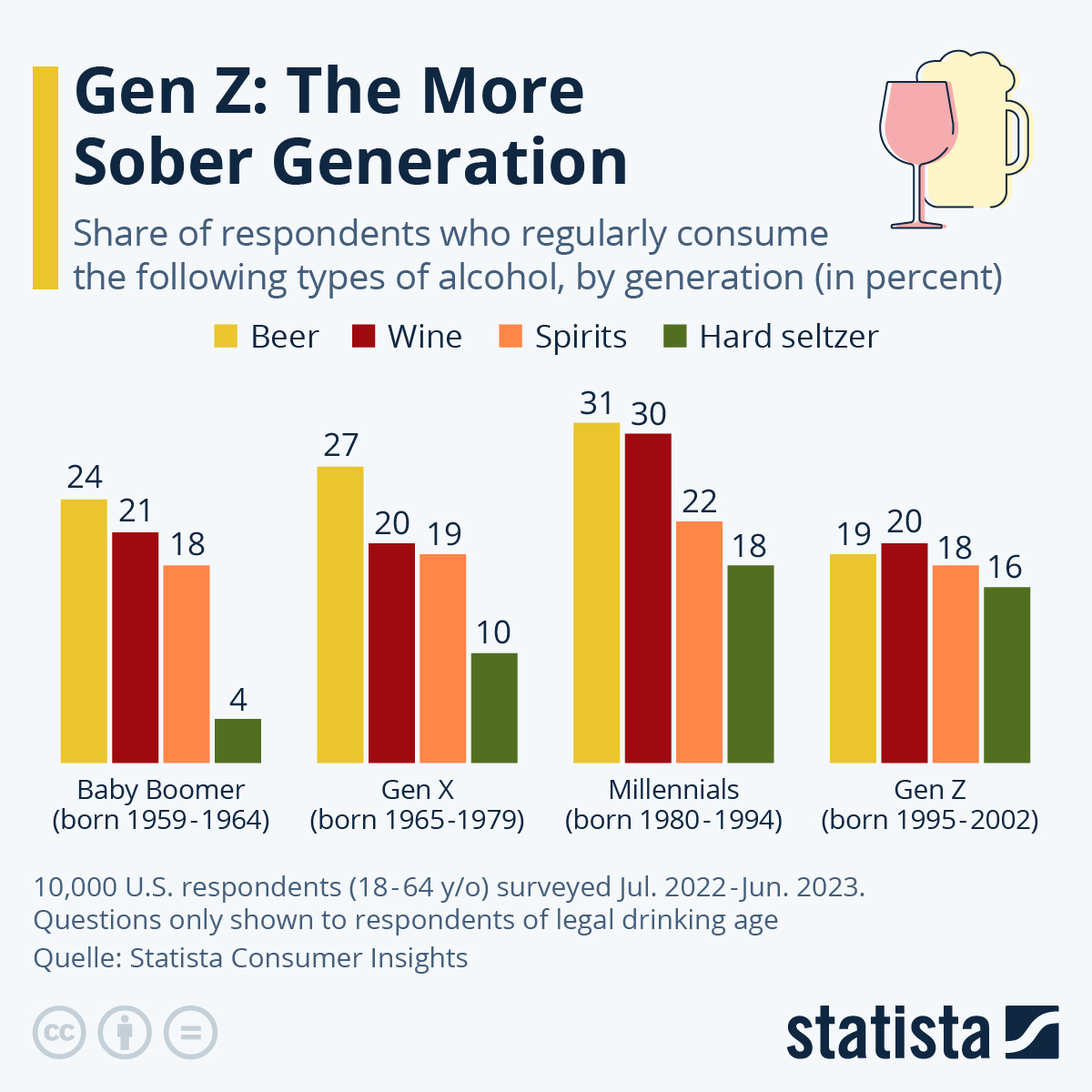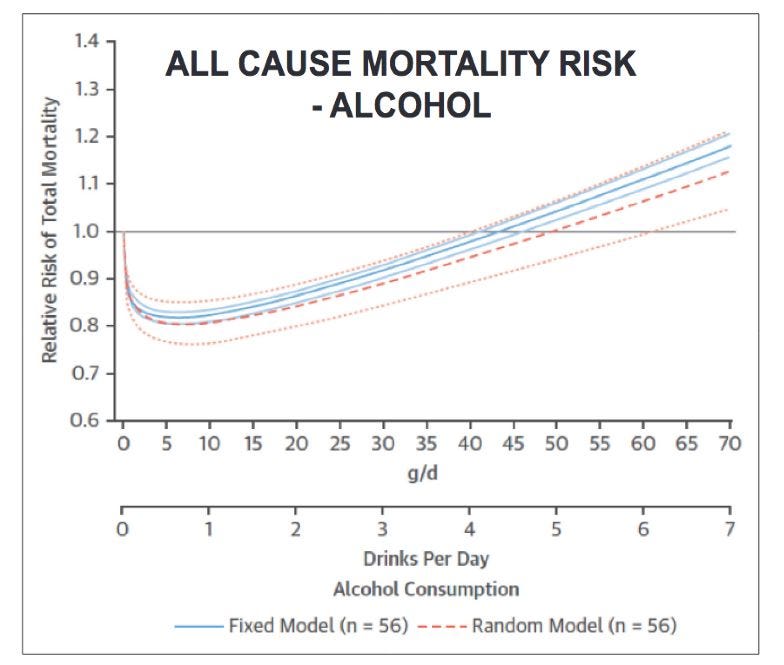Tannic Panic! Issue #87: Dry January Part 2: Electric Boogaloo
Exactly ~what~ are the health implications of drinking alcohol?
Another year, another sorry excuse of a guest post* from Tannic Panic’s biggest fan-ic: ME (the Victoria kind!).
Dry January hates to see me coming because a.) I’ve got recs on recs on recs for the least offensive non-alcoholic wines, and b.) we here at Tannic Panic believe in science (THE GOOD KIND!) and as you’ll soon find out, the relationship between alcohol and health is far more nuanced than fear-mongering headlines suggest.
Before we dive into the juicy stuff, it’s worth exploring the meteoric rise of Dry January in the context of broader cultural shifts toward full sobriety and its impish cousin, the "sober curious" movement – particularly among Gen Z. This generation consumes alcohol way less conspicuously than Millennials (oof, we might need Dry January), with sharp declines in beer and wine consumption.
But it isn’t just Gen Z! Many people choose to take a break from drinking alcoholic beverages during the month of January (aka “Dry January”) for a variety of “personal reasons,” ranging from improving overall “health and wellness” (whatever that means these days) to addressing specific goals like weight loss, mood enhancement, better sleep quality, or simply to prove to themselves that they are capable of the “challenge”(#mybodyisatemple).
So, how significant is alcohol's impact on health, and what role does consumption level play? The answer is complex and context-dependent, shaped by genetics, lifestyle factors, and individual susceptibility. To make informed decisions about drinking, it's critical to unpack “the science”—starting with the "J-shaped curve," a concept that illustrates the relationship between alcohol consumption, all-cause mortality, and specific diseases. For that, I’ll pass it off to Zach!
WHAT IS THE J-SHAPED CURVE?
The "J-shaped curve" of alcohol consumption has long intrigued “researchers” (LIKE ME!), epidemiologists and “health enthusiasts” alike. Put simply, the "J-shaped curve" shows how alcohol affects health (“health” here defined as relative risk of dying of any cause) depending on how much you drink, and it has come up time and time again in a multitude of studies. Here’s what one such study “revealed”…
Light to moderate drinkers, about 0.5 to 3 drinks a day, tend to have a lower risk of death from any cause than people who don’t drink at all, with the lowest risk around half a drink per day.
However, as consumption increases beyond moderate levels, the apparent protective effect diminishes and eventually reverses, leading to increased mortality risk. This J-shaped relationship persists even after adjusting for potential confounding factors such as smoking status, age, sex, BMI, and socioeconomic status (because richer people with more access to “premium” alcohol as well as “premium” healthcare and other “perqs” are more likely to imbibe the nectar of the gods on a more regular basis and also more likely to get good healthcare that prevents other health issues from becoming serious problems).
Interestingly, even at what many would consider a heavy level of alcohol consumption (5+ drinks/day), the relative risk compared to the alcohol abstaining group is around 1, which indicates essentially no difference in level of risk.
BEYOND THE CURVE: INDIVIDUAL FACTORS
The J-shaped curve provides useful insights into population-wide trends, but personal decisions about alcohol should account for more than averages. Here are key considerations:
Genetics: Variants like the PNPLA3 gene can amplify alcohol’s effects on liver damage, increasing vulnerability.
Current Health: Pre-existing conditions, such as cardiometabolic issues, may alter alcohol’s risks and benefits.
Lifestyle Habits: Protective factors like coffee consumption, which has been shown to lower the risk of liver disease even in heavy drinkers, can mitigate some risks.
Subjective Experience: The enjoyment of a glass of wine or the role it plays in social connection can contribute positively to mental well-being and overall quality of life.
ALCOHOL IN PERSPECTIVE: THE BIG PICTURE
A comprehensive meta-analysis of over 4.8 million participants found no significant mortality risk reduction for moderate drinkers but did identify increased risks for women drinking more than 25g (about 2 drinks) daily and men exceeding 45g (3 drinks). This suggests that light to moderate alcohol consumption is largely compatible with a healthy lifestyle, particularly when balanced against personal preferences and behaviors.
COFFEE: A CURVEBALL
Now how about a drink for which there is much stronger and more robust data supporting a direct connection between health and consumption?
Adding context to the conversation is coffee, a surprisingly powerful ally for drinkers. Studies show that 4+ cups of coffee per day can reduce the risk of alcohol-related liver cirrhosis by up to 80% and provide broader health benefits, such as reducing risks of type 2 diabetes, Parkinson’s disease, and even all-cause mortality.
That means that in theory, just drinking 4 cups of coffee a day could potentially save the livers of 8 out of 10 heavy drinkers who would otherwise develop severe liver damage. 😱
TO SUM UP
While moderate alcohol consumption is unlikely to significantly harm health for most people, it’s also not a magic elixir. Instead, it’s one piece of a broader lifestyle puzzle, best enjoyed in balance with good nutrition, exercise, and habits like drinking coffee (seriously—drink coffee).
But if you’re curious (either sober-curious OR the regular kind), take our collective Tannic Panic Hand™ and enter the Looking Glass with us!
… AND NOW FOR THE REVIEWS (IN ORDER OF PRICE):
1. Cruse Brut Sparkling Non-Alcoholic Wine / 👍 / $9.99
Profile: Lemon head candy, minute maid lemonade (THE GOOD KIND!), pears, floral tea, wet stone
Palate: Medium-sweet, high acid, light bodyBright and zippy, this reminds me of a lemon Italian soda—but without the cloying sweetness. Technically medium sweet (~53g/l sugar), it comes across more like an off-dry delight. The sugar is beautifully balanced with the acidity, much like a perfectly blended lemonade. Even if you’re not into sweeter wines, this one might surprise you. It’s incredibly approachable—doesn’t taste like traditional wine, but it’s so drinkable. A fantastic option for someone skipping "the hard stuff" or just looking for something refreshingly different.
2. St Regis Brut Sparkling Non-Alcoholic Wine / 👎 / $12.99
Profile: Baby wipes, artificial “mountain air” candle scent, indistinct used fruit
Palate: Sweet, high acid, medium bodyThis wine claims to be “Brut” (LOL!!!!!), but don’t be fooled—it’s undeniably sweet. The fruit tastes off, with an overripe, almost stale vibe, like dried fruit left forgotten in the pantry. Any sparkle it had disappears in minutes, leaving it lifeless and flat. It’s neither a good wine nor a good drink in general.
3. Good Twin Non-Alcoholic Sparkling White Wine / 👍 / $15.99
Profile: White peach, poached pear, guava, citrus, white tea
Palate: Dry, high acid, light bodyThis NA sparkling wine brings tons of vibrant flavor, with juicy peach, guava, white tea, and poached pear aromas leaping from the glass. It’s got a lush, fruit-forward profile that’s beautifully balanced by high acidity and a creamy mousse. Despite being sugar-free—yes, a hot “0” g/l—it delivers big on taste, feeling both refreshing and indulgent.
Last year, this one wowed us with its spot-on sparkling wine experience, and it still holds up. The light body, off-dry vibe, and long finish make it an excellent choice for anyone looking to skip the alcohol but still enjoy something truly special. Honestly? This is party-ready, no alcohol necessary.
Want more recs for the good the bad and the dealcoholized?
For those who choose to pause drinking, whether for Dry January or long-term change, the benefits might lie less in long-term health effects and more in improved daily routines, mental clarity, and self-discipline.
Ultimately, the decision to drink—or not—should be based on informed, personal considerations, not fear-driven headlines or oversimplified interpretations of the science.
Cheers to that!
Got any hot takes or questions about the science? Did we miss something? ARE WE WRONG?!?!! Come at us in the comments and we’d be happy to answer your queries and/or fight to the death. After all, Zach has a “PhD” in “science.”
Until next time, HAPPY DRINKING PEOPLE.
Victoria & Zach & Isaac (oh my!)
*With a great deal of help from the Tannic Panic braintrust
















Well done!!!
I basically live on coffee and wine. Now I know how I'm pulling that off! ;P